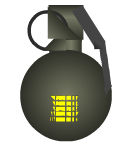KN-60
| KN-60 | |
|---|---|
 | |
| Type | Fragmentation grenade |
| Place of origin | Astronea |
| Service history | |
| In service | 1962-present |
| Used by | Astronean Armed Forces |
| Production history | |
| Designer | Bavra Chemical Solutions |
| Designed | 1960 |
| Manufacturer | ACC Defence Division |
| Unit cost | $80 |
| Produced | 1961-present |
| Specifications | |
| Length | 86 mm (3.4 in) |
| Effective firing range | 123 m (135 yd) |
| Filling | Composition B |
| Filling weight | 0.18 kg |
Detonation mechanism | pyrotechnic delay fuze—4 seconds |
| Blast yield | 5 m (fatal), 15 m (injury) |
| References | |
The KN-60 is a cost effective fragmentation grenade in service with Astronean Armed Forces since the 1960s. Rugged, primitive, but effective, the KN-60 uses a delayed fuse activated by a striker located in a safety lever which is kept in place by a safety pin, much like other contemporary grenades. Each grenade contains approximately 180 g of Composition B explosive cased in a steel cylinder.
The fuze is ignited when the safety pin is removed and the grenade is thrown. Inertia will then cause the striker to hit the fuze cap in midair, igniting the pyrotechnic delay element. The ensuing explosion causes shards of metal to hurdle through the air at extrme velocity, causing injury and death to those close enough to the blast.
The KN-60 has proven invaluable in all theatres, especially urban warfare. Astronean troops have perfected the technique of grenade lobbing indoors, a method of throwing that causes the grenade to bounce around the walls and floors of an interior, making it incredibly difficult to catch and throw back at the operator.
The KN-60 has been produed by Bavra Chemical Solutions since the 1960s, along with other explosive munitions and demolition products for the Astronea Armed Forces and civilian sectors.
Overview
The KN-60 grenade has a spherical steel body that contains 6.5 oz (180 g) of composition B explosive. It uses a pyrotechnic delay fuze. The KN-60 grenade weighs 14 oz (400 g) in total and has a safety clip to prevent the safety pin on the grenade from being pulled accidentally. The safety pin prevents the safety lever, or "spoon" on the grenade from moving and releasing the spring-loaded striker which initiates the grenade's fuze assembly.
The KN-60 can be thrown 30 to 35 metres (98 to 115 ft) by the average male soldier. Its fuze delays detonation between 4 and 5 seconds after the spoon is released. Steel fragments (not to be confused with shrapnel) are provided by the grenade body and produce an injury radius of 15 metres (49 ft), with a fatality radius of 5 metres (16 ft), though some fragments can disperse as far out as 250 metres (820 ft).
Design
To deploy the KN-60 grenade, the user first removes the safety clip from the grenade.
Next, the grenade's pull ring is grasped with the non-throwing hand while maintaining a firm grasp on the body of the grenade and safety lever (also referred to as the "spoon") with the throwing hand. The pull ring and safety pin assembly are fitted so that a right-handed thrower can grasp the grenade with the fuse assembly on top and the safety lever held down by the right thumb. A left-handed thrower should grasp the grenade with the fuse assembly on the bottom and the safety lever held down by the left thumb.
The user then pulls the grenade and pull ring assembly apart, removing the safety pin from the fuse assembly. At this time, the fuse remains unfired, as the throwing hand's thumb is holding the safety lever down.
The user then throws the grenade at the intended target, taking care that the grenade does not strike an obstacle that could deflect the grenade, bounce it back towards the thrower or allow it to roll towards the thrower or an unintended place. When the grenade is thrown, the safety lever will fly free (under pressure from the striker spring) and the striker will hit the cap, igniting the pyrotechnic delay element. When the delay element has burned approximately 4 to 5 seconds it will initiate the grenade's explosive filler, causing a large number of metal fragments to be projected at high velocities. The thrower and friendly personnel in the vicinity should take cover to protect themselves from unintended injury.